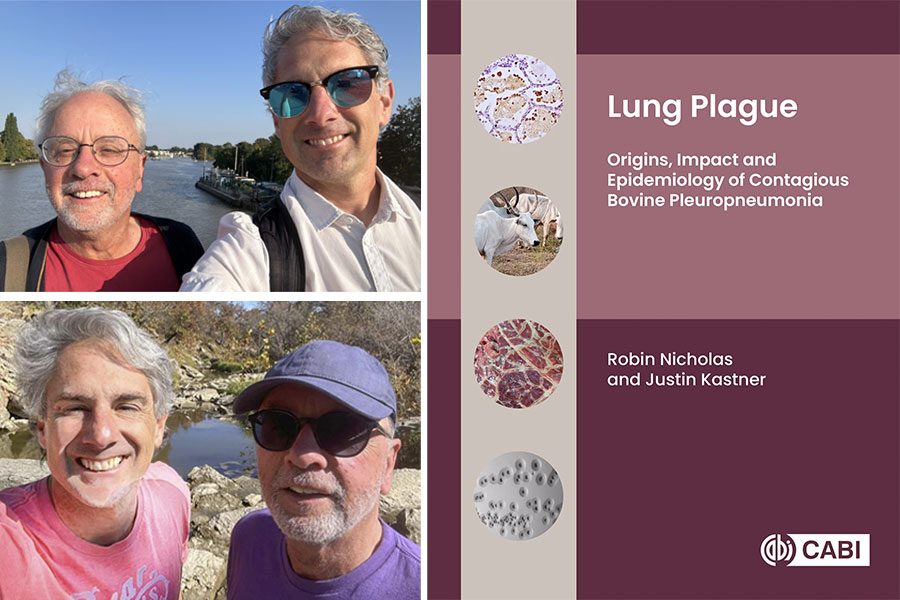Tracing "Lung Plague" across centuries
By Rylee Coy

Left: Cover of Lung Plague: Origins, Impact and Epidemiology of Contagious Bovine Pleuropneumonia. Top right: Drs. Justin Kastner and Robin Nicholas near the United Kingdom National Archives in England. Bottom right: Drs. Kastner and Nicholas at Pillsbury Crossing near Manhattan, Kansas.
What began with a single email in May 2023 has grown into an international friendship — and a book that dives into the story of one of the most devastating cattle diseases.
Dr. Justin Kastner, professor in the Department of Diagnostic Medicine/Pathobiology at the Kansas State University College of Veterinary Medicine, and Dr. Robin Nicholas, former head of the Mycoplasma Group at the UK’s Animal and Plant Health Agency, have co-authored "Lung Plague: Origins, Impact and Epidemiology of Contagious Bovine Pleuropneumonia," released this summer by CABI.
“On May 17, 2023, I went to work and opened up my email, and I had an email from Dr. Robin Nicholas,” Dr. Kastner said. “Basically what he was saying is he had come across an article I had written on the history of this disease. I immediately sent him a copy and said, ‘Hey, let’s have a Zoom so we can kind of get to know each other.’”
Before starting to write the book, Dr. Kastner and Dr. Nicholas collaborated on an article that analyzed British and American experiences with CBPP, published in the journal Veterinary History.
“One of the things I discovered after we had finished this article was that we had so much more information than we could fit into that paper,” Dr. Nicholas said. “So, I said to Dr. Kastner, ‘Hey, we’ve got enough for a book here.’ He agreed almost immediately.”
The book traces the history of CBPP, also known as “lung plague,” back to the early 16th century and follows its spread across Europe, the Americas, Africa, Asia and Australia. While largely eradicated today, CBPP continues to cause significant problems in Sub-Saharan Africa, leading to economic hardships for farmers. For centuries, the disease has shaped agricultural economies, food systems and even political decisions around the world.
The pair worked across time zones and continents, meeting regularly on Zoom, emailing drafts back and forth, and traveling to each other’s home countries — Dr. Nicholas in Farnham, England, and Dr. Kastner in Manhattan, Kansas. They dove into historical archives in both countries, exploring how the disease affected different regions.
“Dr. Kastner showed me the wonders of the archive,” Dr. Nicholas said. “Previously, I was less methodical in how I looked around libraries and used online databases. He was able to show me how to better use these sources, some of which were completely new to me. With Dr. Kastner’s help, I handled a book from 1523 that I found in the British Library in England which probably contained the first mention of the disease.”
Their discoveries include an 1843 shipping record for a cow purchased in New York that brought CBPP to the Northeast region of the United States. The book also highlights veterinarians, regulators and farmers who confronted the disease long before germ theory was accepted.
“Part of success is putting teams together that complement each other,” Dr. Kastner said. “Dr. Nicholas brought his career of experience, his scientific mind, and I brought my historical research I had done on this disease and the trade drama.”
The 184-page book contains 12 chapters and is available through CABI and Amazon. While priced primarily for libraries, chapters can be purchased individually, broadening access for students, veterinarians, historians and anyone interested in CBPP or the spread of animal disease and control.
###
For more information about the Kansas State University College of Veterinary Medicine, please visit our website at vet.k-state.edu or follow us on Facebook, Instagram, and X.